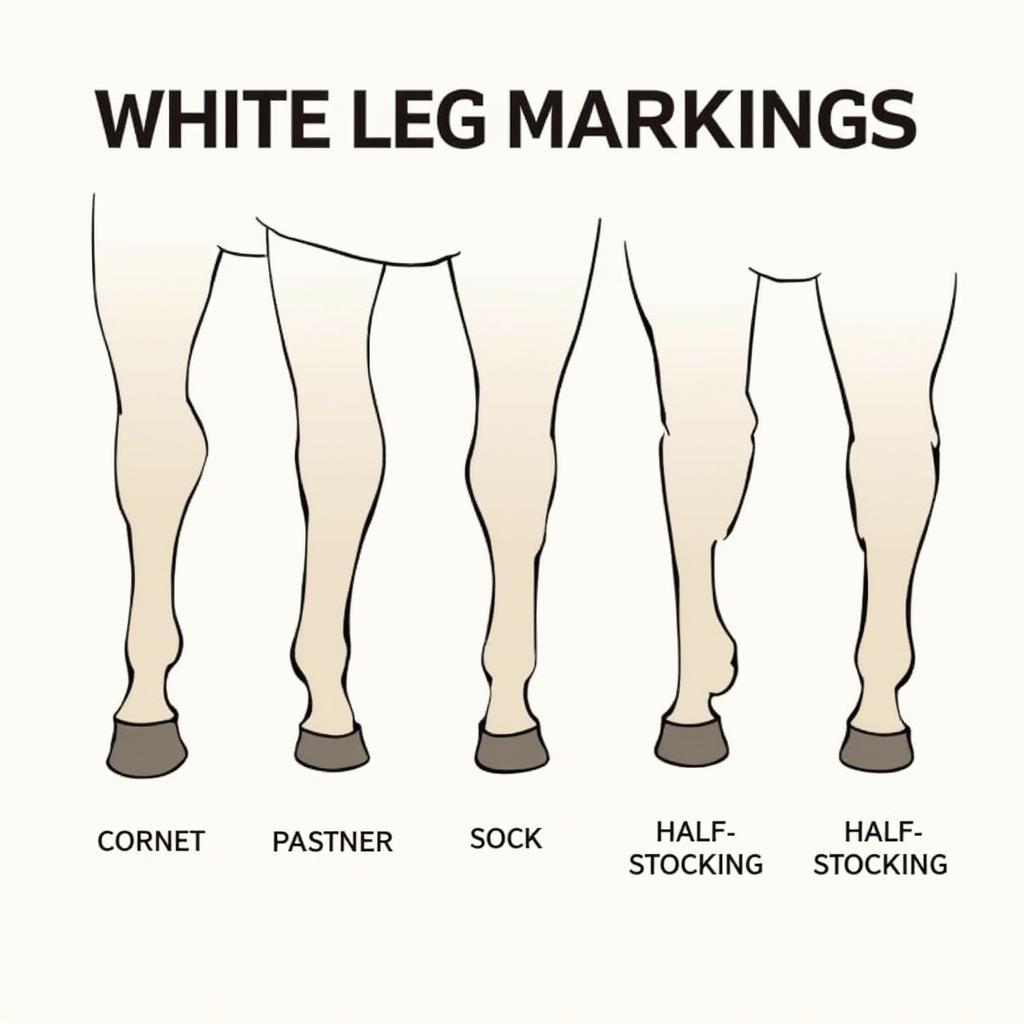Quarter markings on a horse can be a fascinating subject, adding a unique touch to their appearance. Whether you’re a seasoned horse owner or simply an admirer, understanding these markings can provide insights into a horse’s individuality. This article will delve into the world of quarter markings, exploring their variations, genetics, and what they might tell us about the horse.
 Quarter Horse Leg Markings
Quarter Horse Leg Markings
Decoding Quarter Horse Leg Markings: What Do They Mean?
Quarter markings, typically found on the legs of horses, are areas of white hair. They vary greatly in size and shape, ranging from a small “sock” just covering the pastern to a “stocking” that reaches the knee or even higher. These markings are especially common in certain breeds, such as sorrel paint horse and Quarter Horses, but they can appear in many different breeds. They are distinct from other white markings like blazes or stars on the face. The terms “sock,” “half-stocking,” and “stocking” are commonly used to describe the height of the white marking on the leg.
The presence of quarter markings doesn’t necessarily correlate with any particular health or temperament traits. They are primarily considered cosmetic features, adding to the horse’s overall aesthetic. However, they can be useful for identification purposes, much like a fingerprint. Each horse’s markings are unique, making it easier to distinguish individuals, especially in a herd.
Dr. Amelia Hart, equine geneticist, notes, “Quarter markings are a fascinating example of how even small genetic variations can result in noticeable physical differences in horses. They offer a glimpse into the complex interplay of genes that determine coat color and patterns.”
Genetics of Quarter Markings: A Deeper Dive
Like other coat colors and patterns, quarter markings are influenced by specific genes. While the exact genetic mechanisms behind these markings are still being studied, it’s known that multiple genes contribute to their development. These genes affect the production and distribution of melanin, the pigment responsible for hair and skin color.
Understanding the genetic basis of quarter markings can help breeders predict the likelihood of these patterns being passed down to offspring. It’s important to note that the inheritance of coat color and markings is complex and not always predictable. Just because a parent has quarter markings doesn’t guarantee its offspring will have them, and vice versa.
Quarter Markings vs. Other White Leg Markings
While the term “quarter marking” is often used generically for white markings on a horse’s legs, it’s important to distinguish them from other white markings that can occur in similar areas. For instance, “coronet” markings are small white bands just above the hoof, while “pastern” markings cover the pastern area. “Fetlock” markings extend slightly higher, encompassing the fetlock joint.
 Comparing Leg Markings on Horses
Comparing Leg Markings on Horses
Identifying a westerner horse with Quarter Markings
Quarter markings can be a valuable tool for identifying individual horses, particularly in breeds like Quarter Horses or cisco horse where they are common. By noting the specific height and shape of the white markings on each leg, owners can create a detailed record of their horse’s appearance. This information can be crucial for registration purposes, insurance claims, and even recovering a lost horse.
Caring for a Horse with Quarter Markings: Are there Special Needs?
Having quarter markings doesn’t require any special care beyond regular grooming. However, it’s essential to keep the white areas clean to prevent staining and maintain their bright appearance. Regular brushing and occasional washing can help remove dirt and debris that might discolor the white hair.
Conclusion: Appreciating the Unique Beauty of Quarter Marking Horses
Quarter markings contribute to the incredible diversity and individuality seen in horses. They are a testament to the complex genetic tapestry that shapes these magnificent animals. Whether you’re interested in black appaloosa horses or a beautiful gray horse paint, understanding quarter markings adds another layer to our appreciation of their unique beauty.
FAQ
- What are the different types of quarter markings?
- Are quarter markings hereditary?
- Do quarter markings indicate anything about a horse’s health?
- How can I clean my horse’s white leg markings?
- What is the difference between a sock and a stocking marking?
- Can quarter markings be used for identification purposes?
- Do all Quarter Horses have quarter markings?
For any support please contact us Phone: 0772127271, Email: [email protected] or Location: QGM2+WX2, Vị Trung, Vị Thuỷ, Hậu Giang, Việt Nam. We have a 24/7 customer support team.